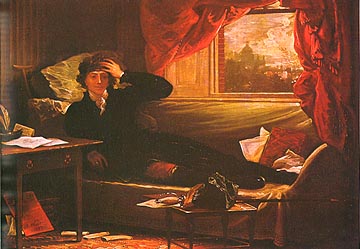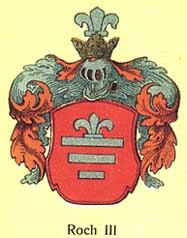
Thaddeus Kosciuszko (1746-1817)(Tadeusz Kosciuszko in Polish)
2006 Marks the 260th Anniversary of his Birth
Written and researched by Margaret Odrowaz Sypniewski

After he was wounded.
|
PLEASE NOTE: ***Tadeusz or Thaddeus (Hebrew) means "Courageous and valiant." This name fits Tadeusz Kosciuszko well, since he (like St. Thaddeus) fought for the hopeless and difficult causes. St. Thaddeus was one of the twelve apostles of Jesus Christ and is also known as St. Jude (see link below). I have used the original spelling (Hebrew) here upon these pages so people can identify our hero's given name with that of the saint, whom most believe he was named after. I have received only one criticism about this, but since I am writing for an English-speaking audience, I have used the English spelling of this name and duly noted that the Polish spelling was Tadeusz. |

steel engraving of Kosciuszko
- His elder brother, Josef Tomasz was a spend thrift (Mizwa).
- His one sister, Anna Kosciuszko, was married to Piotr Estko (Mizwa)
- a sister ?
- Tadeusz Kosciuszko
The name Kosciuszko is of Ruthenian origin. The name can be traced back to Konstanty, son of Teodor. Konstanty was said to be a judge and official in the Kamieniec region in the Ukraine. William F. Hoffman states that an author named Tadeusz Korzon, who wrote Kosciuszko Biografia z documentow wysnuta. This member of the Kosciuszko family was "pan Kostiuszko Fedorowicz," and that his formal name in the Ukraine was Konstantym from the Greek "Constantine." Therefore Koscuiszko means "little Constantine." Another relative of Tadeusz was called Hrehory Kostiuszko. The Polish would be "Grzegorz Kosciuszko" (Hoffman, 42).
It is thought (from the Hoffman book) that Hrehory used a Ukrainian name and was a follower of the Greek Church, rather than the Roman Catholic. Hoffman says that the family spoke Polish (Hoffman, 43), because Poland ruled the Ukraine at this time. The family estate was divided between sons named Iwan and Fedor, in latter years.
His family was Polonized in the 16th century. His father died when Thaddeus was twelve-years-old. Thaddeus's share of his father's estate was small, since it was mortgaged. In spite, he still received a classical education at a local Polish Catholic Church school, run by the Piarist Fathers. His best subjects were:
- Mathematics
- Geometry
- Drawing - he did landscapes of Polesie and portraits of people he knew.
He received a Captain's commission. King Stanislaw August Poniatowski and the Czartoryski family then provided the scholarship monies for Thaddeus to study in Paris. This school was established by King Poniatowski. Thaddeus studied engineering and artillery. He was commissioned Colonel of Engineers in 1776. He chose the career of arms and he was trained in France.
- In 1777, he went to the United States, when his own country was torn with strife:
- He served in George Washington's Army.
- He fought for the colonists in the War of Independence (1775-1783).
- He fought at Ticonderoga and helped win at Saratoga.
- He also served under General Greene in the Southern Department. He surveyed the North Carolina rivers, and fought in many Southern battles.
- As an engineer at West Point, he built the fortifications which were key elements in defense of navigation along the Hudson River.
Thaddeus Kosciuszko was offered United States citizenship, but he returned to Poland in 1784, as a brigadier general, but he was penniless because Congress could not afford to pay his salary. He lived temporarily in his paternal estates and contemplated the American Revolution and how Poland might overcome its own crisis. He was known as "the Washington of Poland," as he led his own people in a revolution. By 1794, his troops were defeated, and he was critically wounded and captured by the Russians. Two years later, he returned to the Americas. After a brief stay, he returned to Europe and he died in Switzerland, while in exile, still holding on to his support of the Polish revolution. Thomas Jefferson was the executor of his American will. Kosciuszko left all his American funds for the cause of Black freedom and education.
When Russia attacked his country, in 1792, he brought his 4000 men and held Dobienska for five days against 18,000 Russians. On 1794, after the second partition of Poland,he headed a national movement in Kracow, and was appointed dictator and commander-in-chief. His defeat of the Russian force at Raclawice was followed by an uprising in Warsaw. He established a provisional government and took the field, but, defeated, fell back upon Warsaw and maintained himself there; until, overpowered by superior numbers in the battle of Maciejowice, on October 10, 1794. He was gravely wounded and taken prisoner. He remained weakened after this. Two years later the emperor Paul I of Russia restored him to liberty. He went to England, then America (in 1797). He then left America in May 1798. He left his will with his friend Thomas Jefferson. The will was dated May 5, 1798. He left his American property for the purpose of:
purchasing Negroes from among his [Jefferson's] own or any other and giving them liberty in my name, in giving them an education in trades or otherwise and having them instructed for their new condition in the duties of morality ... an in whatsoever may make them happy and useful
The times would not allow all his wishes and his poverty later on in his life left little in his estate. However many believe he was sincere in his desire to upgrade the condition of blacks in the Americas, just as he hoped to emancipate the peasants in Poland.
Finally, in 1798, Kosciuszko went to France. In France he was a farmer near Fountainebleau. In 1806 he refused to support Napoleon's plan for the restoration of Poland. Kosciuszko died October 15, 1817 (Soleure, Switzerland). He was to be remembered as a soldier and patriot. Kosciuszko died when he fell over a precipice, when his horse balked (Magnusson, 1993, 839).
Kosciuszko had an unhappy youth full of sadness and disappointments. As an adult he was admired. His heart was buried in Rapperswill, free Switzerland, until Poland was made free again.
Kosciuszko's home in the U.S.A. was at 310 Pine Street in Philadelphia, Pennsylvania. This house was made into the Thaddeus Kosciuszko National Memorial. Statues of Kosciuszko are at West Point and at Saratoga, U.S.A.
Kosciuszko is emtombed in Wawel Castle at Cracow, the centuries-old burial place of the kings of Poland. His heart is now in the Royal chapel in Zamek Krolewski. At Wawel Castle there is a statue of him on horseback. Another statue stands in Warsaw, Poland. And a kopiec (little hill)dedicated to him stands in Warsaw, Poland.He was a national hero both here and in Poland. "In Poland he received the Polish Order of the Virtuti Militari, the highest honor for military valor" (Prof. Dr. Zdzislaw P. Wesolowski)

Another Kosciuszko arms was the Roch - ZKSP III (?)
I do not know which one of these arms is Kosciuszko's arms. Which one of these two variations is from his family, I do not know for positive.
SOURCES:
Hoffman, William F. Polish Surnames: Origins and Meanings. Chicago: Polish Genealogical Society of America, 1993.
Magnusson, Magnus. Larousse Biographical Dictionary. KBE, 1993, 839.
Mizwa, Stephen P. Great Men and Women of Poland New York: The Kosciuszko Foundation, 1967.
Wilson, Robert H. Thaddeus Kosciuszko and His Home in Philadelphia Philadelphia: Copernicus Society of America, 1976.
RELATED LINKS:
The Kosciuszko Foundation ... Thaddeus Kosciuszko: A Polish Son of Liberty
The Purest Son of Liberty by James S. Pula (1999) ... Tadeusz Kosciuszko (1746-1817) Part I

View My Guestbook
Sign My Guestbook
Last updated on April 24, 2007
© 2000 Maggie973@aol.com
